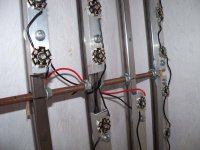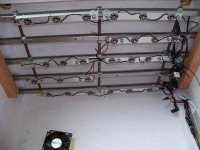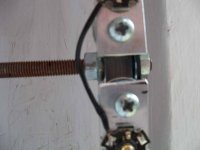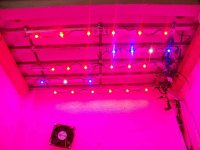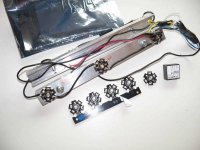One alternative to the plain old drivers is a buck puck type of current controller. I used some that do a variable voltage from 5 (I think) to 32 volts... good enough for up to 7 three-watt LEDs that I used. They even come in a bunch of different currents, and some can even be hooked up to microcontrollers (like Arduino or Maple boards) very easily for PCM effects, if you want to go all nerdy with your rigs. They even have some with dimmers, in case you want to tone down your blues, or whatever...
Another thing is power supplies, for sure. Me, I like to use wall-warts, and other easily bought and replaced (my reason for making my own LED stuff) appliances. You have to - excuse me, you MUST - use as a switching power supply trasnformer. You can buy an ac to dc adapter that reads "24 volts output" right on it... but plug it in, and touch a multimeter to it, and it's reading 32 volts, maybe 28, whatever... enough to ruin everything if you go on blind faith in what you read. A switching power supply has some sort of integrated circuit that keeps the voltage stable output, despite what may be going on in the wires in your warehouse/apartment building/home.
Building your own LED rig can be a serious mental (and possibly costly) chore, especially if you have no real idea about the math, materials, or the methods of manufacturing it. By making your own you actually run around the hype marketing hogwash of 1W vs 3W, and the 3,4,5 or 18 wavelenghth "reasoning" why you should buy something for HUNDREDS of dollars more than it costs to build a truly custom unit for primary or some really awesome supplemental lighting.
Another thing is power supplies, for sure. Me, I like to use wall-warts, and other easily bought and replaced (my reason for making my own LED stuff) appliances. You have to - excuse me, you MUST - use as a switching power supply trasnformer. You can buy an ac to dc adapter that reads "24 volts output" right on it... but plug it in, and touch a multimeter to it, and it's reading 32 volts, maybe 28, whatever... enough to ruin everything if you go on blind faith in what you read. A switching power supply has some sort of integrated circuit that keeps the voltage stable output, despite what may be going on in the wires in your warehouse/apartment building/home.
Building your own LED rig can be a serious mental (and possibly costly) chore, especially if you have no real idea about the math, materials, or the methods of manufacturing it. By making your own you actually run around the hype marketing hogwash of 1W vs 3W, and the 3,4,5 or 18 wavelenghth "reasoning" why you should buy something for HUNDREDS of dollars more than it costs to build a truly custom unit for primary or some really awesome supplemental lighting.

